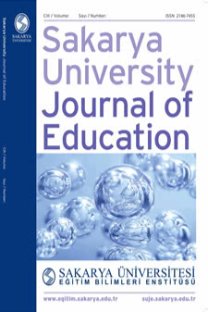A New Alternative to Museum Activities in Teaching Social Studies Course: “360-Degree Videos as a Virtual Museum”
social studies teaching, virtual museum, virtual reality,
___
- Andrews, J. (1998). A New Medium for Old Masters: The Kress Study Collection Virtual Museum Project. Art Documentation: Journal of the Art Libraries Society of North America, 17(1), 19-27. Retrieved from http://www.jstor.org/stable/27948930
- Ata, B. (2002). Müzelerle ve tarihi mekanlarla tarih öğretimi: Tarih öğretmenlerinin “müze eğitimine” ilişkin görüşleri (Yayımlanmamış doktora tezi). Gazi Üniversitesi Sosyal Bilimler Enstitüsü Tarih Eğitimi Anabilim Dalı. Ankara.
- Cheng, Y., & Wang, S. H. (2011). Applying a 3D virtual learning environment to facilitate student’s application ability–The case of marketing. Computers in Human Behavior, 27(1), 576-584.
- Çolak, C. (2006). Sanal Müzeler inet-tr 11. Türkiye‟de İnternet Konferansı Bildirileri, 21-23 Aralık, TOBB Ekonomi ve Teknoloji Üniversitesi 293-296.
- da Silva, M. H., do Espírito Santo, A. C., Marins, E. R., de Siqueira, A. P. L., Mol, D. M., & de Abreu Mol, A. C. (2015). Using virtual reality to support the physical security of nuclear facilities. Progress in Nuclear Energy, 78, 19-24.
- Emmelkamp, P. M. G., Krijn, M., Hulsbosch, A. M., De Vries, S., Schuemie, M. J., & Van der Mast, C. A. P. G. (2002). Virtual reality treatment versus exposure in vivo: a comparative evaluation in acrophobia. Behaviour research and therapy, 40(5), 509-516.
- Ermiş, B. (2010). İlköğretim 6.Sınıf Öğrencilerinin Görsel Sanatlar Dersinde “Üç Boyutlu Sanal Müze Ziyareti” Etkinliğine İlişkin Görüşleri. Yayınlanmamış Yüksek Lisans Tezi, Gazi Üniversitesi Eğitim Bilimleri Enstitüsü, Ankara.
- Giangreco I., Sauter L., M.A.Parian,. Gasser R., Heller S., Rossetto L. & Schuldt H. (2019) IUI '19: Proceedings of the 24th International Conference on Intelligent User Interfaces: CompanionMarch 2019 Pages 119–120https://doi.org/10.1145/3308557.3308706
- Güleç, S. and Alkış, S. (2003). “Sosyal Bilgiler Öğretiminde Müze Gezilerinin İletişimsel Boyutu” Uludağ Üniversitesi, Eğitim Fakültesi Dergisi, Cilt: XVII, 1: 63-78.
- Güler, H, Şahinkayası, Y. & Şahinkayası H. (2017), İnternet ve mobil teknolojilerin yaygınlaşması: Fırsatlar ve sınırlılıklar. Sosyal Bilimler Dergisi, 7(17), 186-207.
- Howard, M. C. (2017). A meta-analysis and systematic literature review of virtual reality rehabilitation programs. Computers in Human Behavior, 70, 317-327.
- Huang, H. M., Rauch, U., & Liaw, S. S. (2010). Investigating learners’ attitudes toward virtual reality learning environments: Based on a constructivist approach. Computers & Education, 55(3), 1171-1182.
- Jang, S., Vitale, J. M., Jyung, R. W., & Black, J. B. (2017). Direct manipulation is better than passive viewing for learning anatomy in a three-dimensional virtual reality environment. Computers & Education, 106, 150-165.
- Kuliga, S. F., Thrash, T., Dalton, R. C., & Hölscher, C. (2015). Virtual reality as an empirical research tool—Exploring user experience in a real building and a corresponding virtual model. Computers, Environment and Urban Systems, 54, 363-375.
- Lee, E. A. L., Wong, K. W., & Fung, C. C. (2010). How does desktop virtual reality enhance learning outcomes? A structural equation modeling approach. Computers & Education, 55(4), 1424-1442.
- Malkoç, S. (2014). Sosyal bilgiler öğretiminde sınıf dışı okul ortamlarının kullanılma durumları (Yayınlanmamış Yüksek Lisans Tezi). Anadolu Üniversitesi Eğitim Bilimleri Enstitüsü, Eskişehir.
- McKenzie, J. (1997). Building a virtual museum community. In Museums and the Web. Conference (pp. 77-86). MEB, (2018). Milli Eğitim Bakanlığı, Sosyal Bilgiler Dersi Öğretim Programı (İlkokul ve Ortaokul 4,5,6, ve 7. Sınıflar), Ankara
- Merchant, Z., Goetz, E. T., Cifuentes, L., Keeney-Kennicutt, W., & Davis, T. J. (2014). Effectiveness of virtual reality-based instruction on students' learning outcomes in K-12 and higher education: A meta-analysis. Computers & Education, 70, 29-40.
- Miles, M., & Huberman, A. (1994). Qualitative Data Analysis (2nd edition). Thousand Oaks, CA: Sage Publications.
- Monahan, T., McArdle, G., & Bertolotto, M. (2008). Virtual reality for collaborative e-learning. Computers & Education, 50(4), 1339-1353.
- Öner, G. (2015). Sosyal bilgiler öğretmenlerinin ‘okul dışı tarih öğretimi’ne ilişkin görüşlerinin incelenmesi. Turkish History Education Journal, 4(1), 89-121.
- Schweibenz, W. (2019). The virtual museum: an overview of its origins, concepts, and terminology. The Museum Review. (4)1.
- Takeuchi K., Hayashi M. & Hirayama M.J. (2019). International Workshop on Advanced Image Technology (IWAIT) 2019; 110491B (2019) https://doi.org/10.1117/12.2521304
- Yıldırım, A., & Şimşek, H. (2013). Sosyal Bilimlerde Nitel Araştırma Yöntemleri. Ankara: Seçkin Yayıncılık.
- Yildirim, T., & Tahiroğlu, M. (2012). Sanal ortamda gerçekleştirilen müze gezilerinin ilköğretim öğrencilerinin sosyal bilgiler dersine yönelik tutumlarına etkisi. Elektronik Sosyal Bilimler Dergisi, 11(39), 104-114.
- Ustaoğlu, A. (2012). İlköğretim 7. Sınıf sosyal bilgiler dersi Türk tarihinde yolculuk ünitesinde sanal müzelerin kullanımının öğrenci başarısına etkisi (Yayınlanmamış yüksek lisans tezi). Gazi Üniversitesi Eğitim Bilimleri Enstitüsü İlköğretim Anabilim Dalı. Ankara.
- ISSN: 2146-7455
- Yayın Aralığı: 3
- Başlangıç: 2011
- Yayıncı: Sakarya Üniversitesi Eğitim Bilimleri Enstitüsü
Ali KIRKSEKİZ, Onur İŞBULAN, Akiper@sakarya.edu.tr AKİPER@SAKARYA.EDU.TR, Selçuk TERCAN, Mübin KIYICI
Eda GENÇ, Hacer ÇALIŞKAN, Assoc. Prof. Doğan YÜKSEL
Ortaöğretim Biyoloji Ders Kitaplarında Değerlerin Analizi
Eda GENÇ, Hacer ÇALIŞKAN, Doğan YÜKSEL
Onur İŞBULAN, Mübin KIYICI, Aydın KİPER, Ali KIRKSEKİZ, Selçuk Sırrı TERCAN
Lise Öğrencilerinin Motivasyon Kaynakları ve Karar Verme Stratejileri
